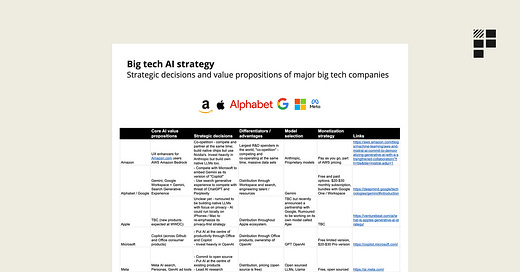DoP Deep: AI product strategies compared
Lessons from Amazon, Stripe, StackOverflow and more to help you create your own AI product strategy
🔒DoP Deep goes deeper into the concepts and ideas that are covered in the Weekly Briefing to help you learn lessons from the experiences of top tech companies. If you’d like to upgrade to receive them you can do so below. Or you can find out more about what you get as a paid subscriber here.
Hi product people 👋,
Product teams are under a lot of pressure to develop an AI strategy right now. And because of the speed at which new technologies are being developed, by the time you've carved out some space to think about what your strategy might look like, it can sometimes feel like parts of it are already out of date.
We’ve explored AI features in previous deep dives but in this DoP Deep, we’re going to take a step back from focusing purely on specific features and instead unpack some of the strategic decisions and approaches currently being made by top-tier companies, so that if you’re currently thinking about your own product’s strategy, you can use these lessons to help shape it.
Coming up:
The 5 strategic decisions which underpin AI product strategies
Deep dives into the AI strategies of a variety of top tier tech companies including:
Big tech (Google, Amazon, Apple, Microsoft, Meta)
Stack Overflow
Stripe
How to craft your AI product strategy
Lessons and principles from these companies you can use to craft your own product’s AI strategy
The 5 strategic decisions that underpin AI product strategy
AI strategy, like product strategy more broadly, is a process that involves making clear decisions and trade offs. Some of these decisions will have a greater impact on the success or failure of your product than others, but each decision plays its own role in determining the trajectory of your business.
In an AI context, developing a strategy involves answering one or more of the following five questions:
Value - what value does adding AI add to your product and why are you doing it?
Competition and differentiation - what role does your product play in the AI-enabled world how are you going to differentiate vs your competition? Does AI pose an existential threat to your company? How might you evolve to meet those threats?
Model selection - which model are you going to use? Will you build your own proprietary LLMs or use third parties? Why?
Monetization - how do AI features fit into your existing monetization strategy?
Skills and talent - what specialist skills and talents do you have to bring this AI strategy to life? Are there talent gaps in essential areas like ML?
In this deep dive we’ll use these 5 areas to help us analyse the strategic decisions made by top tier tech companies. And more importantly - how you can use these lessons and insights to shape your own product’s AI strategy.
We’ll unpack the strategic decisions made by 3 distinct groups of products to help us get a broad perspective on strategy development. These include: big tech companies, smaller companies who face potential existential threats due to AI and companies who are positioning themselves to support the AI initiatives of others.
First, let’s take a look at the current state of big tech and each of their AI strategies.
Big tech AI strategy
For the purpose of this deep dive, we’re defining big tech as the group which includes Amazon, Alphabet, Apple, Microsoft and Meta.
Here’s a snapshot of the strategic position of the major big tech companies including their core value propositions, decisions, differentiators and monetization strategies:
Let’s take a look at some of these in a bit more depth to understand some of the key strategic decisions each of these companies has made - along with some thoughts about what these mean for product teams developing their own strategies.
Amazon
Key strategic decisions: co-opetition, make AWS the centre of AI products, not the models powering them
In a recent interview, Amazon’s CEO declared that “co-opetition” was at the heart of the company’s AI strategy. Co-opetition is a term used to describe companies who compete and cooperate with each other at the same time - typically for mutual benefit.
Co-opetition at Amazon manifests itself in a few ways: Amazon is building its own AI chips while also partnering with Nvidia. The company is building its own LLMs while also investing heavily in Anthropic and Claude. It’s a smart strategy - and is similar to its broader AWS strategy; Amazon cooperates with Prime Video competitors like Netflix, for example, by providing cloud computing services.
Amazon is also developing its own AI value propositions which reinforce its strategy of co-opetition.




